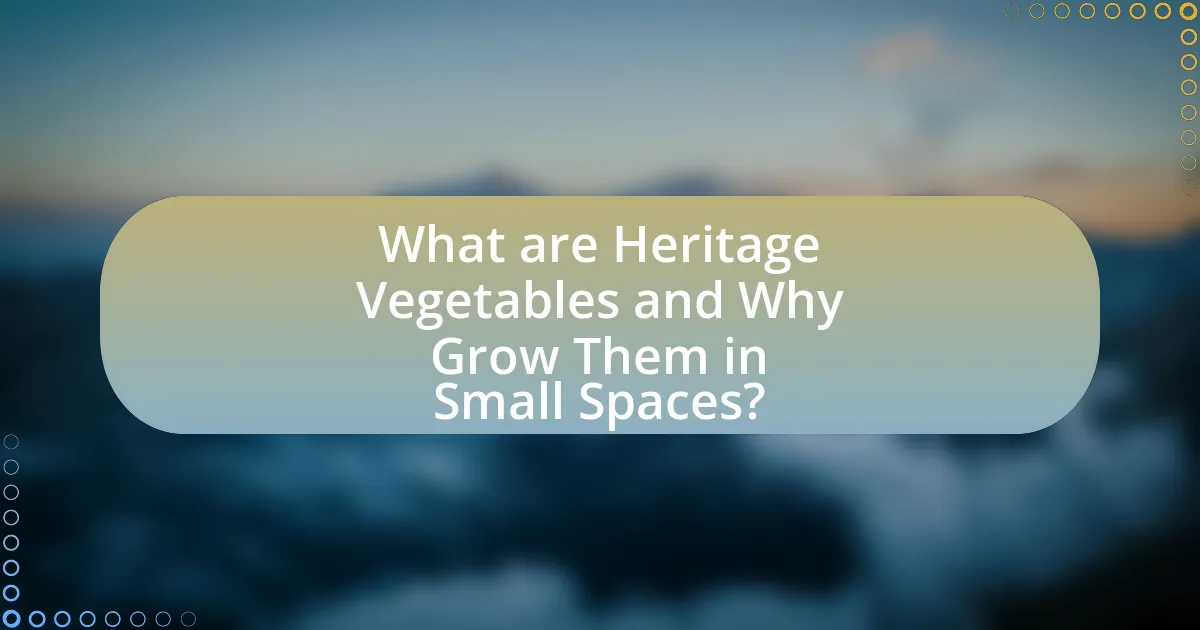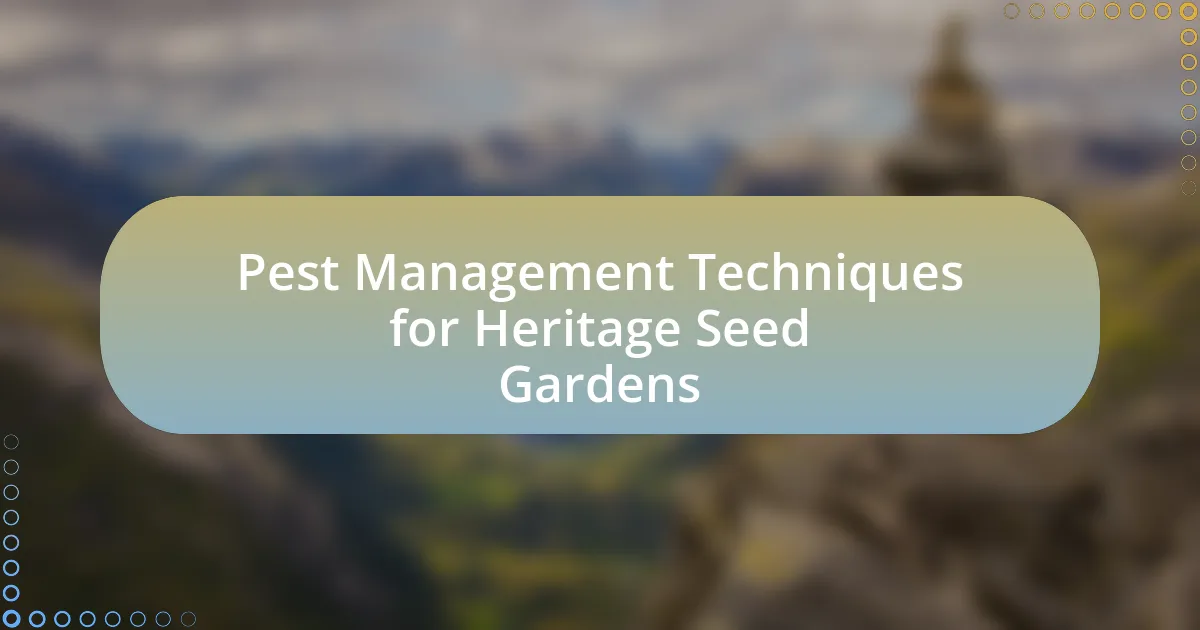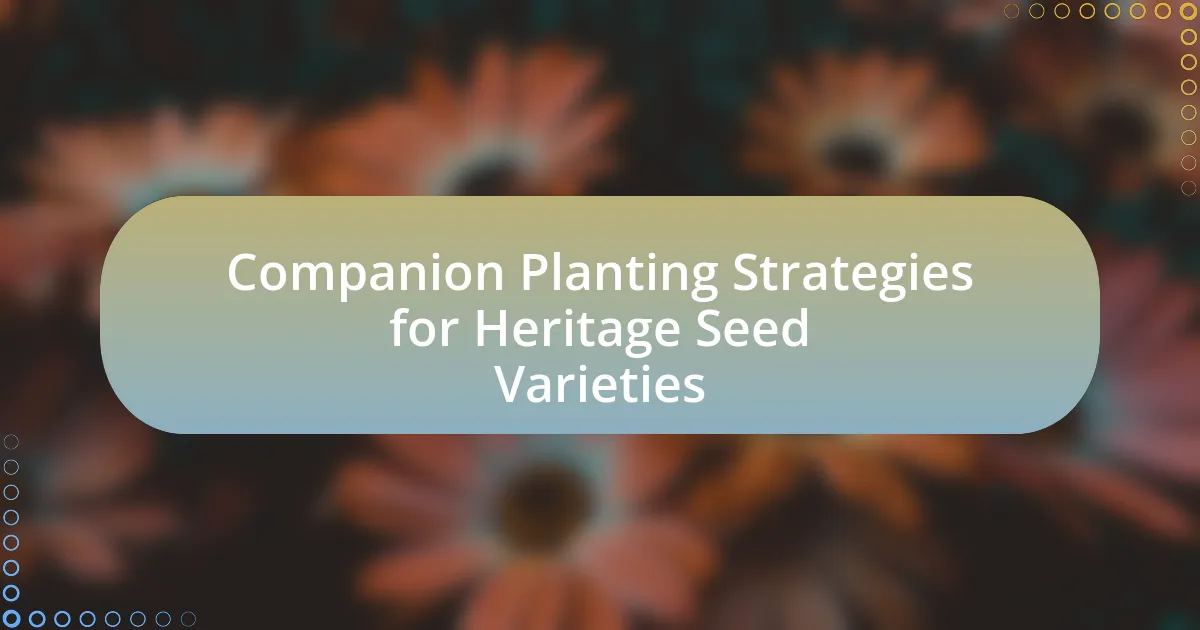Heritage vegetables are traditional varieties known for their unique flavors, colors, and resilience, making them ideal for cultivation in small spaces. This article explores the benefits of growing heritage vegetables, including their superior taste and nutritional value compared to modern hybrids, as well as their role in supporting biodiversity and preserving agricultural history. It addresses the challenges faced by small space gardeners, such as limited sunlight and soil volume, and presents effective techniques like container gardening, vertical gardening, and square foot gardening to maximize yield. Additionally, the article highlights best practices for maintaining soil quality, managing pests, and optimizing watering to ensure successful growth of heritage vegetables in confined environments.

What are Heritage Vegetables and Why Grow Them in Small Spaces?
Heritage vegetables are traditional varieties that have been passed down through generations, often characterized by their unique flavors, colors, and resilience. Growing heritage vegetables in small spaces is beneficial because these varieties typically adapt well to limited environments, allowing for diverse cultivation even in urban settings. Additionally, heritage vegetables often have better taste and nutritional profiles compared to modern hybrids, making them a valuable choice for home gardeners. Their cultivation supports biodiversity and preserves agricultural history, which is crucial for sustainable food systems.
How do heritage vegetables differ from modern varieties?
Heritage vegetables differ from modern varieties primarily in their genetic diversity and flavor profiles. Heritage vegetables are open-pollinated, meaning they can reproduce true to type, preserving unique traits and flavors that have been cultivated over generations. In contrast, modern varieties are often hybridized for uniformity, higher yields, and resistance to pests, which can result in a loss of flavor and nutritional value. Research indicates that heritage varieties often contain higher levels of certain nutrients and antioxidants compared to their modern counterparts, making them not only a flavorful choice but also a potentially healthier one.
What are the unique characteristics of heritage vegetables?
Heritage vegetables are characterized by their traditional cultivation methods, genetic diversity, and unique flavors. These vegetables are often open-pollinated, meaning they can reproduce true to type, preserving their distinct traits over generations. Unlike hybrid varieties, heritage vegetables typically exhibit a broader range of colors, shapes, and sizes, which can enhance biodiversity in gardens. Additionally, many heritage varieties have historical significance, having been cultivated for generations, which contributes to their cultural value. Studies have shown that these vegetables often possess superior taste profiles compared to commercial varieties, making them desirable for culinary uses.
Why are heritage vegetables important for biodiversity?
Heritage vegetables are important for biodiversity because they contribute to genetic diversity within agricultural systems. This genetic diversity enhances ecosystem resilience, allowing crops to adapt to changing environmental conditions and resist pests and diseases. For instance, heritage varieties often possess unique traits that have been lost in modern hybrids, such as drought resistance or specific nutrient profiles, which can be crucial for food security. Studies have shown that maintaining a wide range of plant genetic resources, including heritage vegetables, is essential for sustainable agriculture and the preservation of ecosystems.
What challenges do gardeners face when growing in small spaces?
Gardeners face several challenges when growing in small spaces, including limited sunlight, restricted soil volume, and difficulty in managing water and nutrients. Limited sunlight can hinder plant growth, as many vegetables require at least six hours of direct sunlight daily. Restricted soil volume affects root development and nutrient availability, making it essential for gardeners to choose compact or dwarf varieties that thrive in confined areas. Additionally, managing water and nutrients becomes more complex due to the smaller growing medium, which can lead to overwatering or nutrient depletion if not monitored closely. These challenges necessitate careful planning and selection of appropriate gardening techniques to ensure successful cultivation of heritage vegetables in small spaces.
How does limited space affect plant selection?
Limited space significantly influences plant selection by necessitating the choice of compact, high-yielding varieties that maximize productivity in confined areas. For instance, gardeners often opt for dwarf or bush varieties of vegetables, such as determinate tomatoes or compact squash, which require less room to grow while still producing a substantial harvest. Additionally, vertical gardening techniques can be employed to further optimize space, allowing for the cultivation of climbing plants like peas and beans, which utilize vertical structures instead of horizontal ground space. This strategic selection and arrangement of plants not only enhance the efficiency of space usage but also contribute to a more diverse and productive garden in limited areas.
What are common mistakes made by small space gardeners?
Common mistakes made by small space gardeners include overcrowding plants, neglecting soil quality, and failing to plan for sunlight exposure. Overcrowding can lead to competition for nutrients and water, ultimately stunting growth; studies show that plants need adequate spacing to thrive. Neglecting soil quality often results in poor drainage and nutrient deficiencies, as healthy soil is crucial for plant development. Additionally, failing to assess sunlight exposure can lead to inadequate light for photosynthesis, which is essential for plant health. Research indicates that most vegetables require at least six hours of direct sunlight daily to produce effectively.

What Techniques Can Be Used to Grow Heritage Vegetables in Small Spaces?
Techniques to grow heritage vegetables in small spaces include container gardening, vertical gardening, and square foot gardening. Container gardening allows for the cultivation of various heritage vegetable varieties in pots or raised beds, optimizing limited space while providing good drainage and soil control. Vertical gardening utilizes trellises or wall-mounted systems to grow climbing plants, maximizing vertical space and increasing yield per square foot. Square foot gardening involves dividing a small garden area into square sections, allowing for intensive planting of different heritage vegetables, which can lead to higher productivity in confined areas. These methods are supported by urban gardening practices that emphasize efficient use of space and resources.
How can vertical gardening be applied to heritage vegetables?
Vertical gardening can be applied to heritage vegetables by utilizing vertical structures such as trellises, wall planters, and hanging pots to maximize space and enhance growth. This method allows for the cultivation of various heritage vegetable varieties, such as heirloom tomatoes and climbing beans, in limited areas, making it ideal for urban gardening. Studies indicate that vertical gardening can increase yield by up to 30% compared to traditional gardening methods, as it improves air circulation and sunlight exposure, which are crucial for the health of heritage plants.
What structures are best for vertical gardening?
The best structures for vertical gardening include trellises, wall planters, and vertical garden systems. Trellises provide support for climbing plants, allowing them to grow upward and maximize space. Wall planters utilize vertical surfaces to hold pots or containers, effectively using walls for planting. Vertical garden systems, such as modular planters or hydroponic towers, are designed specifically for growing plants in a vertical arrangement, optimizing light exposure and air circulation. These structures are effective because they enhance space efficiency, improve accessibility, and can increase yield in limited areas, making them ideal for growing heritage vegetables in small spaces.
Which heritage vegetables thrive in vertical setups?
Heritage vegetables that thrive in vertical setups include pole beans, cucumbers, and tomatoes. These plants benefit from vertical gardening as they utilize upward space, allowing for better air circulation and sunlight exposure. Pole beans, for instance, can grow up to 10 feet tall when supported by trellises, while cucumbers and indeterminate tomatoes also produce higher yields in vertical arrangements. Studies have shown that vertical gardening can increase crop density and reduce disease incidence, making it an effective technique for growing these heritage vegetables in limited spaces.
What role does container gardening play in small space vegetable cultivation?
Container gardening is essential for small space vegetable cultivation as it maximizes limited growing areas by allowing plants to be grown in various locations, including patios, balconies, and urban environments. This method enables gardeners to utilize vertical space and optimize sunlight exposure, which is crucial for the growth of heritage vegetables. Research indicates that container gardening can increase yield per square foot compared to traditional gardening methods, making it an effective strategy for urban dwellers with restricted land access. Additionally, containers can be moved to adapt to changing light conditions, further enhancing the potential for successful vegetable production in confined spaces.
What types of containers are suitable for heritage vegetables?
Terracotta pots, wooden planters, and fabric grow bags are suitable containers for heritage vegetables. Terracotta pots provide excellent drainage and aeration, which is essential for the healthy growth of heritage varieties. Wooden planters offer a natural aesthetic and good insulation for roots, while fabric grow bags promote air pruning of roots, preventing them from becoming root-bound. These container types are widely used in urban gardening and small space cultivation, making them effective choices for growing heritage vegetables.
How can soil quality be maintained in containers?
Soil quality in containers can be maintained by regularly replenishing nutrients, ensuring proper drainage, and monitoring pH levels. Regularly adding organic matter, such as compost or well-rotted manure, enhances nutrient content and improves soil structure. Proper drainage prevents waterlogging, which can lead to root rot and nutrient leaching. Additionally, testing and adjusting the pH to an optimal range (typically between 6.0 and 7.0 for most vegetables) ensures that plants can effectively absorb nutrients. These practices are supported by research indicating that maintaining nutrient levels and soil structure is crucial for healthy plant growth in container gardening.

What Best Practices Should Be Followed for Successful Growth?
To achieve successful growth of heritage vegetables in small spaces, it is essential to implement practices such as selecting appropriate varieties, optimizing soil quality, and ensuring adequate sunlight. Selecting heritage vegetable varieties that are well-suited for small spaces, such as dwarf or compact types, maximizes yield in limited areas. Optimizing soil quality involves using nutrient-rich, well-draining soil and incorporating organic matter, which has been shown to improve plant health and productivity. Ensuring that plants receive at least six hours of sunlight daily is crucial, as sunlight directly influences photosynthesis and growth rates. These practices are supported by agricultural studies indicating that proper variety selection, soil management, and light exposure significantly enhance vegetable growth and yield in constrained environments.
How can gardeners maximize yield in limited space?
Gardeners can maximize yield in limited space by employing vertical gardening techniques, which allow for the cultivation of plants upwards rather than outwards. This method increases the planting area and can lead to higher productivity; for example, a study by the University of Florida found that vertical gardening can increase yields by up to 50% compared to traditional methods. Additionally, using companion planting can enhance growth and deter pests, further optimizing the limited space available.
What planting techniques enhance space efficiency?
Intensive planting techniques enhance space efficiency by maximizing the number of plants per area. Techniques such as square foot gardening, vertical gardening, and companion planting allow for optimal use of limited space. For instance, square foot gardening divides a garden into small, manageable sections, enabling the planting of various crops in a compact area, which can increase yield by up to 100% compared to traditional row planting. Vertical gardening utilizes structures to grow plants upwards, effectively doubling the planting area. Companion planting involves strategically placing plants together to improve growth and deter pests, further optimizing space and resources.
How does companion planting benefit heritage vegetables?
Companion planting benefits heritage vegetables by enhancing their growth, improving pest control, and increasing biodiversity in small spaces. This technique involves strategically planting compatible species together, which can lead to improved nutrient uptake and healthier plants. For example, planting basil alongside tomatoes can enhance tomato flavor and deter pests like aphids. Studies have shown that companion planting can reduce the need for chemical pesticides, promoting a more sustainable gardening practice. Additionally, the diversity created through companion planting can lead to a more resilient ecosystem, which is particularly beneficial for heritage vegetables that may be more susceptible to diseases and pests.
What are the best tips for maintaining heritage vegetables in small spaces?
To maintain heritage vegetables in small spaces, prioritize container gardening, as it allows for efficient use of limited areas. Use pots or raised beds to provide adequate drainage and soil depth, which is essential for the health of heritage varieties. Implement vertical gardening techniques, such as trellises or wall planters, to maximize growing space while ensuring that plants receive sufficient sunlight. Regularly monitor soil moisture and nutrient levels, as heritage vegetables often require specific care to thrive; using organic fertilizers can enhance growth and flavor. Additionally, practice crop rotation and companion planting to prevent pests and diseases, which is crucial for maintaining the health of these unique varieties.
How can pests and diseases be managed effectively?
Pests and diseases can be managed effectively through integrated pest management (IPM) strategies, which combine biological, cultural, mechanical, and chemical practices. For instance, introducing beneficial insects like ladybugs can naturally control aphid populations, while crop rotation and companion planting can disrupt pest life cycles and enhance plant health. Research indicates that IPM can reduce pesticide use by up to 50%, promoting a healthier ecosystem and sustainable agriculture.
What are the best watering practices for small space gardens?
The best watering practices for small space gardens include using drip irrigation or soaker hoses to deliver water directly to the roots, ensuring efficient moisture retention. These methods minimize water waste and reduce evaporation, which is crucial in compact areas where plants may compete for limited resources. Additionally, watering early in the morning or late in the evening helps to prevent water loss due to heat and allows plants to absorb moisture effectively. Research indicates that consistent moisture levels improve plant health and yield, making these practices essential for successful small space gardening.





